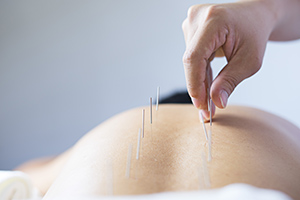"Simplicity, patience, and compassion. These three are your greatest treasures." — Lao Tze
Simplicity is a critical concept whenever discussing how to create acupuncture point protocols. Students and clinicians alike often use more points than necessary in valiant efforts to help suffering patients. Creating simple, yet effective point protocols can be challenging; however, this does not have to be the case. Let's discuss the important foundational front mu / back shu points and how these points can be used to create effective three-point acupuncture formulas.
The Power of Three
The front mu points are unique areas where the qi of the zang fu gathers and concentrates on the anterior surface of the body. The back shu points are areas where the qi of the respective zang fu emanates from the interior to the exterior body surface, resulting in a powerful regulating and tonifying action.
When the front mu and back shu points are combined, extremely powerful two-point acupuncture formulas are created. These two-point formulas can be expanded to three-point formulas with the addition of distal points on the respective meridians, the paired meridian or other meridians related to the particular pattern presentation of the patient. The following are examples of how clinicians can create such front mu / back shu / distal point prescriptions.
Respiratory Patterns
 The following three-point prescriptions are highly effective for a wide range of respiratory and lung meridian-related issues:
The following three-point prescriptions are highly effective for a wide range of respiratory and lung meridian-related issues:
- BL 13 (back shu of lung) + Lu 1 (front mu) + BL 43 (moxa)
- BL 13 (back shu of lung) + Lu 1 (front mu) + Lu 7
- BL 13 (back shu of lung)) + Lu 1 (front mu) + Ren 17 (influential point of qi / front mu of pericardium)
All of the aforementioned three-point prescriptions can be used for many types of respiratory issues, both acute and chronic; and can be modified as needed with the simple addition of one point, resulting in efficient four-point prescriptions.
Digestive Patterns
- BL 20 (back shu of spleen) + Liv 13 (front mu of spleen) + St 36
- BL 18 (back shu of liver) + Liv 13 (front mu of spleen) + Sp 6
- BL 20 (back shu of spleen) + Liv 13 (front mu of spleen) + Liv 3
In many acupuncture traditions, the left Liv 13 is utilized for spleen issues, while the right Liv 13 focuses more on liver issues.
Sleep Disturbance Patterns
- BL 15 (back shu of heart) + Liv 13 (front mu of spleen) + Du 24
- BL 15 (back shu of heart) + Ren 17 (influential point of qi / front mu of pericardium) + HT 7
- BL 15 (back shu of heart) + Ren 17 (influential point of qi / front mu of pericardium) + Kid 3
Clinical Takeaway
These three-point formulas are just basic examples of how such point prescriptions can be created using front mu / back shu points as the foundation. There are many options when it comes to the particular distal point used, allowing for flexibility.
If signs of excess or deficient heat are present, a fourth point can be added. For example, for respiratory patterns with heat, LI 11 or LU 5 can be added to the three-point formulas. In the digestive patterns with heat, ST 44 or Liv 2 can be added to the three-point formulas. In the sleep disturbances patterns with heat, Kid 2 or HT 8 can be added. In cases of significant blood stasis contributing to any pattern, BL 17 can be added.
Whether you're a clinician or a student, go back to the basics and become confident creating effective three- to four-point formulas. Keeping it simple is by no means less advanced. Mastering an art consists of mastering the basics. Remember, there is rarely a quick fix when it comes to healing your patients.
Click here for more information about Craig Williams, LAc, AHG.




